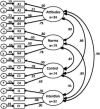COVID-19 Experiences and Social Distancing: Insights From the Theory of Planned Behavior
- PMID: 34074154
- PMCID: PMC8679169
- DOI: 10.1177/08901171211020997
COVID-19 Experiences and Social Distancing: Insights From the Theory of Planned Behavior
Abstract
Purpose: The objective of this study is to identify the relationship between COVID-19 experiences, perceived COVID-19 behavioral control, social norms and attitudes, and future intention to follow social distancing guidelines.
Design: This is a cross-sectional study.
Setting: Participants responded to an on-line survey in June 2020.
Subjects: The study included 3,183 residents within Quebec, Canada aged 18 and over.
Measures: Measures include perceived COVID-19 related discrimination, fear of COVID-19 infection, prior exposure to COVID-19, and prior social distancing behavior. Participants self-reported attitudes, perceived behavioral control, and perceived norms related to social distancing. Finally, we measured social distancing behavioral intention.
Analysis: We evaluated a theory of planned behavior (TPB) measurement model of social distancing using confirmatory factor analysis (CFA). The association between COVID-19 perceived discrimination, fear of infection, previous social distancing behavior, exposure to COVID-19, TPB constructs and behavioral intentions to social distance were estimated using SEM path analysis.
Results: TPB constructs were positively associated with intention to follow social distancing guidelines. Fear of COVID-19 infection and prior social distancing behavior were positively associated with behavioral intentions. In contrast, perceived discrimination was negatively associated with the outcome. Associations between fear of COVID-19, perceived COVID-19 discrimination and behavioral intentions were partially mediated by constructs of TPB.
Conclusions: COVID-19 prevention efforts designed to emphasize positive attitudes, perceived control, and social norms around social distancing should carefully balance campaigns that heighten fear of infection along with anti- discrimination messaging.
Keywords: COVID-19; discrimination; health behavior; health communication; social distancing.
Conflict of interest statement
Figures



Similar articles
-
Social distancing intentions to reduce the spread of COVID-19: The extended theory of planned behavior.BMC Public Health. 2021 Oct 11;21(1):1836. doi: 10.1186/s12889-021-11884-5. BMC Public Health. 2021. PMID: 34635071 Free PMC article.
-
Theory of Planned Behavior Analysis of Social Distancing During the COVID-19 Pandemic: Focusing on the Intention-Behavior Gap.Ann Behav Med. 2021 Jul 22;55(8):805-812. doi: 10.1093/abm/kaab041. Ann Behav Med. 2021. PMID: 34228112 Free PMC article.
-
Factors affecting Pakistani young adults' intentions to uptake COVID-19 vaccination: An extension of the theory of planned behavior.Brain Behav. 2021 Nov;11(11):e2370. doi: 10.1002/brb3.2370. Epub 2021 Sep 20. Brain Behav. 2021. PMID: 34543522 Free PMC article.
-
Psychosocial Determinants of Hand Hygiene, Facemask Wearing, and Physical Distancing During the COVID-19 Pandemic: A Systematic Review and Meta-analysis.Ann Behav Med. 2022 Nov 5;56(11):1174-1187. doi: 10.1093/abm/kaac049. Ann Behav Med. 2022. PMID: 36074717 Free PMC article.
-
Predicting Vaccination Intention against COVID-19 Using Theory of Planned Behavior: A Systematic Review and Meta-Analysis.Vaccines (Basel). 2022 Nov 26;10(12):2026. doi: 10.3390/vaccines10122026. Vaccines (Basel). 2022. PMID: 36560436 Free PMC article. Review.
Cited by
-
Cognitive predictors of COVID-19 mitigation behaviors in vaccinated and unvaccinated general population members.Vaccine. 2023 Jun 19;41(27):4019-4026. doi: 10.1016/j.vaccine.2022.10.004. Epub 2022 Oct 13. Vaccine. 2023. PMID: 36253218 Free PMC article.
-
The role of discrimination in the relation between COVID-19 sequelae, psychological distress, and work impairment in COVID-19 survivors.Sci Rep. 2022 Dec 23;12(1):22218. doi: 10.1038/s41598-022-26332-6. Sci Rep. 2022. PMID: 36564428 Free PMC article.
-
Gender-Related Differences in Social Participation Among Japanese Elderly Individuals During the COVID-19 Pandemic: A Cross-Sectional Survey.J Prim Care Community Health. 2022 Jan-Dec;13:21501319221111113. doi: 10.1177/21501319221111113. J Prim Care Community Health. 2022. PMID: 35818674 Free PMC article.
-
Exploring organizational aspects that promote health-related preventive behavior: using the example of work-related SARS-CoV-2 infection control measures in Germany, August 2020 to November 2021.Front Public Health. 2024 Oct 2;12:1388996. doi: 10.3389/fpubh.2024.1388996. eCollection 2024. Front Public Health. 2024. PMID: 39416946 Free PMC article.
-
Perceived severity, fear of retaliation, and suspect report intention of general public during COVID-19 pandemic: A moderated moderation analysis.J Public Aff. 2021 Aug 5:e2734. doi: 10.1002/pa.2734. Online ahead of print. J Public Aff. 2021. PMID: 34512190 Free PMC article.
References
-
- Armitage CJ, Conner M. Efficacy of the theory of planned behaviour: a meta-analytic review. Br J Soc Psychol. 2001;40(Pt 4):471–499. - PubMed
-
- McEachan RRC, Conner M, Taylor NJ, Lawton RJ. Prospective prediction of health-related behaviours with the theory of planned behaviour: a meta-analysis. Health Psychology Rev. 2011;5(2):97–144.
-
- Rich A, Brandes K, Mullan B, Hagger MS. Theory of planned behavior and adherence in chronic illness: a meta-analysis. J Behav Med. 2015;38(4):673–688. - PubMed
Publication types
MeSH terms
LinkOut - more resources
Full Text Sources
Medical

